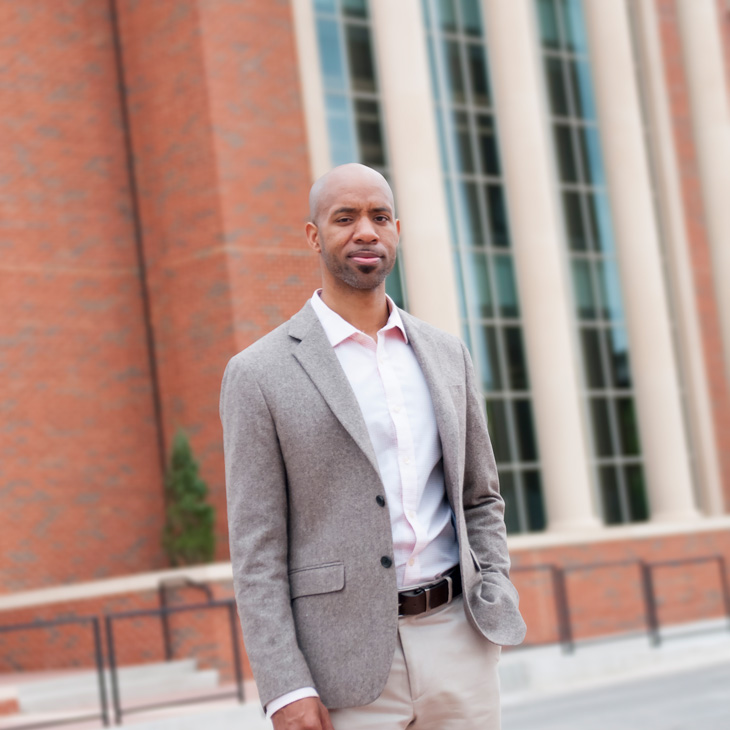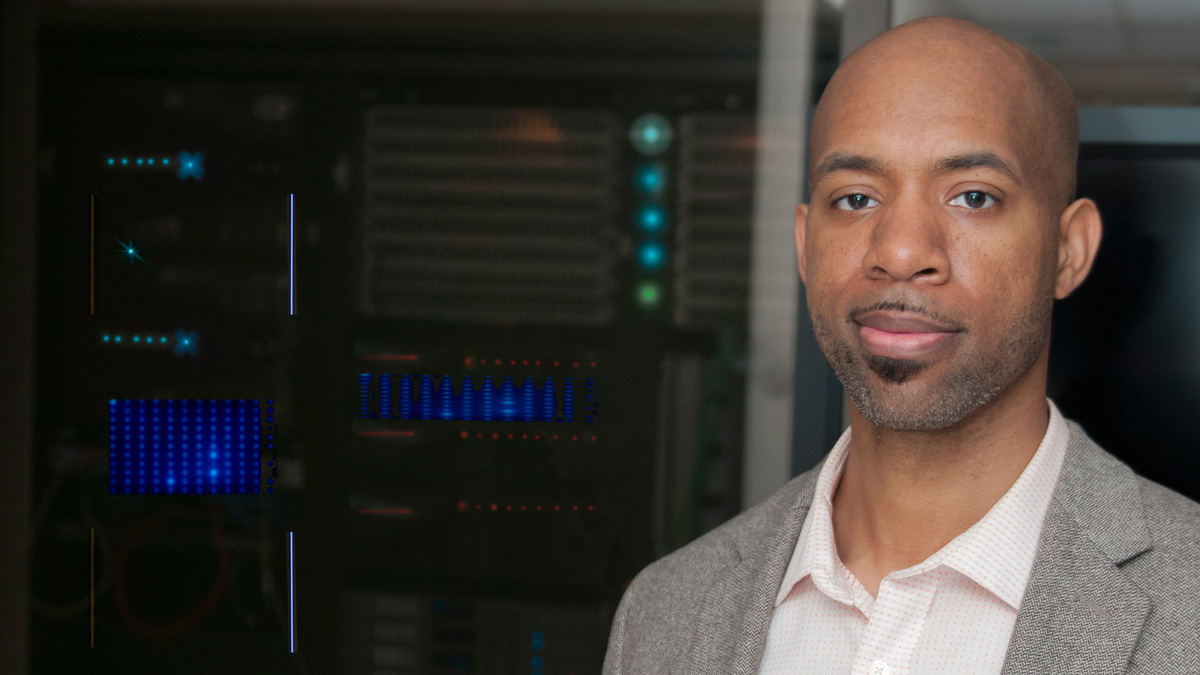Baham to the Rescue

By John Helsley
Corey Baham stood before a room full of IT managers, not quite prepared for the outburst that would follow his presentation.
A standing ovation.
Baham, an Oklahoma State University assistant professor of management science and information systems, delivered his report on a project he’d led for the company, a major health care provider, on rapid IT recovery in the wake of a disaster.
That’s when the 30 or so top-level managers rose in applause, acknowledging Baham and the man who brought him in, the on-site disaster recovery specialist at the company (not identified for industry confidentiality).
“We probably held back from doing a chest bump,” Baham said, “but that was validation if we ever needed it.”
The success of the project was only the beginning. Baham’s research paper, “An Agile Methodology for the Disaster Recovery of Information Systems Under Catastrophic Scenarios,” earned publication in the Journal of Management Information Systems.
“Corey’s work is an example of the practical yet groundbreaking research being done in the MSIS department,” commented Rick Wilson, head of the MSIS department. “We pride ourselves on our rigor and our relevance, and a publication in one of top journals in the field like JMIS is a great start for Dr. Baham’s career. We are very proud of his successes.”
Technology risks
Baham’s work was special on multiple fronts.
Disaster recovery and business continuity planning is one of the top concerns for IT executives. IT downtime can have a huge detrimental impact on a company, from potentially harming its reputation to limiting its ability to conduct business to even threatening its ability to survive.
Companies of all kinds rely heavily on technology, which puts them at risk when systems go down.
“Unfortunately, we’ve seen companies that have had some breaks in (IT) service and how consequential it has been for those companies, even to the extent of going out of business,” Baham said.
“So we see that it’s very, very important for companies to be running on all cylinders at all times. They need to have some solutions in place so if the worst scenario happens, they can still get back operating, at least at a minimal level, very quickly.”
That’s why Baham was brought in, to help develop a plan for the worst of times. When systems go down amid disasters such as floods, hurricanes and tornadoes, they aren’t always easy to restore, with the resulting challenges often forcing technicians to work remotely.
So companies frequently plan ahead to consider possible solutions in handling such disasters. In this case, Baham was sought out for the project for his familiarity with Agile Methodology, which reflects a team’s ability to adjust to conditions and challenges it incurs during a project, rather than follow rigid preset guidelines.
“We wanted to see, what are some Agile principles we could use that would marry well to the problems the disaster recovery specialist was having?” Baham said. “We tried to establish a parallel. What are the problems you are having, and how can Agile help solve those problems?”
To address the challenges of technicians working remotely from potentially multiple locations, Baham adapted Kanban, a scheduling system developed by Toyota to improve manufacturing efficiency. Baham’s project utilized Kanban principles with a video board that allowed everyone involved to monitor the recovery progress and adjust as necessary. A live chat feature allowed even more connection with communication that could combat bottlenecks in the process and enhance the flexibility to move around occurring problems.
And all they needed to pull it off was one simple requirement: a good internet connection.
“Disasters happen randomly, leaving some key people off-site, so it could be a coffee shop or home or any place with wi-fi,” Baham said. “Kanban allows flexibility to be mobile and still stay engaged.”
A real-life test
Baham’s work wasn’t just theoretical, it was put to the test through “Action Research,” the participation of an actual intervention; where results can be recorded and analyzed and, if necessary, tweaked. Twice – once unexpectedly – the plan was thrust into action. The first test came when the health care provider suffered an actual power outage while Baham’s research team was still immersed in the project.
With nothing to lose, the plan was thrown into action, successfully, as the system was restored with help from a Kanban video board vital to the recovery.
“We just turned it on and went for it,” Baham said. “And it went well.

“There’s not a lot of case studies like this where somebody’s waiting around and then an event happens and they capture it perfectly. We had some fortune with this paper, but also we were ready. That in essence is what the paper is about.”
Later, a planned outage again confirmed the research and the method as effective. And soon Baham’s paper gained attention.
“On the research end, we’re trying to bring more awareness to this particular paper, because it’s a little bit different than the typical academic work,” Baham said. “Where this paper was published, in one of the top journals in our field, it was in a special issue on Action Research, because the journal wanted to shed some light on what Action Research is, some of the advances in Action Research, and sort of signal to the field some of the opportunities that are there with doing this type of research.”
The project also provided validation for the company’s disaster recovery manager, as well as Baham, to the point of tempting a chest bump. Today, the health care provider utilizes the Kanban-adapted plan, which — after initially being met with some hesitancy — received a strong endorsement from the company’s vice president of enterprise infrastructure.
“I have been with this company for 25 years,” the man said during Baham’s presentation, “and I can say that this was the smoothest process we have ever had during an outage.”
For Baham, a native of Baton Rouge, Louisiana, the project was both professional and personal. He’d experienced the impact of hurricanes Katrina and Gustav, which brought flooding and massive damage to his home state. In Oklahoma, tornadoes and supercell thunderstorms pose significant threats that could result in emergencies.
“So it was definitely a personal touch for this project, because being from Baton Rouge, it was something I knew could have very tangible results,” Baham said. “And the implementation of this is far-reaching, because it affects a lot of people.
“For this particular company, instead of not having access to some of their health care information for days, now if something like this happens, within the same day, they can trust they can call and have access to their records.”
Expanding dreams
Baham hopes the research can be shared and molded to provide an even greater impact on a grander scale.
“Hopefully, having had this published, we can follow up with the model and expand it to handle larger DR (disaster recovery) events,” Baham said. “Right now, the model can handle a DR effort for a large company, but we’d like to develop one that can handle more of distributed effort, where teams are globally separated, geographically separated, across different sites and that sort of thing.
“We want to see if we can take what we have and scale it to handle companies that may not even be in the same building or same region or same part of the world.”
Already, the project is perceived as a resounding success. The company implemented the plan and encouraged its sister companies to do the same.
Publishing his research in a highly respected journal was among the items on his list of career goals — and ranks as quite an accomplishment.
“I checked a really big box with this one,” Baham said, “because there’s nothing better than working hand in hand with a company, solving a problem that they are really wrestling with and have been wrestling with for years.”
Read the Research
Baham’s research paper, “An Agile Methodology for the Disaster Recovery of Information Systems Under Catastrophic Scenarios,” was published in the Journal of Management Information Systems (Volume 34, No. 3, 2017). Read it at okla.st/Baham.

